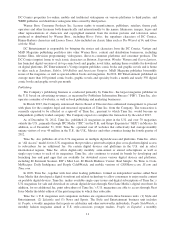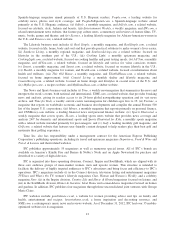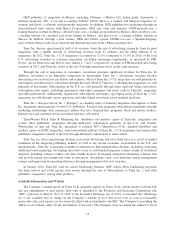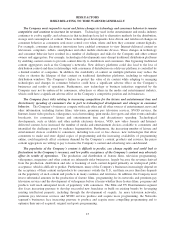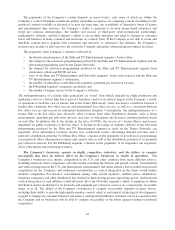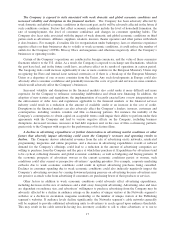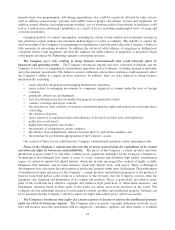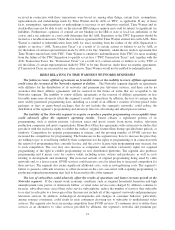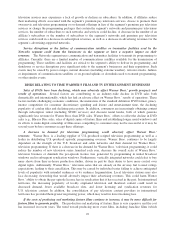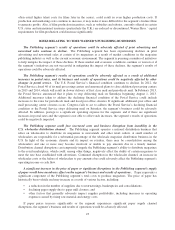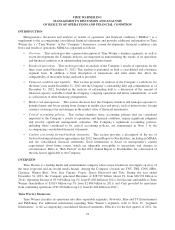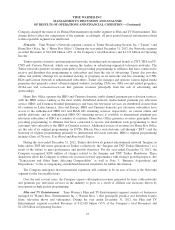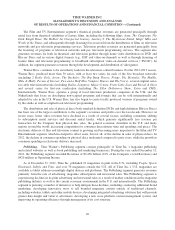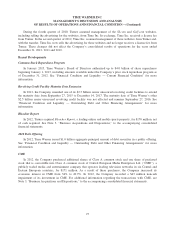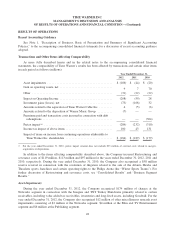Time Magazine 2012 Annual Report Download - page 34
Download and view the complete annual report
Please find page 34 of the 2012 Time Magazine annual report below. You can navigate through the pages in the report by either clicking on the pages listed below, or by using the keyword search tool below to find specific information within the annual report.promote their own programming. Advertising expenditures also could be negatively affected by other factors,
such as shifting societal norms, pressure from public interest groups and changes in laws and regulations. In
addition, natural disasters (including extreme weather), acts of terrorism, political uncertainty or hostilities could
lead to a reduction in advertising expenditures as a result of factors including uninterrupted news coverage and
economic uncertainty.
Changing methods of content consumption, including the advent of time-shifted and on-demand viewing on
new platforms, require audience measurement methodologies to evolve accordingly. The inability to capture the
total viewership of the Company’s programming on all platforms could adversely affect the Company’s ability to
fully monetize its advertising inventory. In addition, the advent of tablet editions of magazines is shifting how
consumers interact with magazines and how the audience for tablet editions of magazines is measured, which
could negatively impact the Publishing segment’s advertising revenues.
The Company faces risks relating to doing business internationally that could adversely affect its
businesses and operating results. The Company’s businesses operate and serve customers worldwide, and the
Company is focused on expanding its international operations in key territories, including through acquisitions
and other strategic investments. The failure to achieve sufficient scale in these territories could negatively affect
the Company’s ability to compete in these territories. In addition, there are risks inherent in doing business
internationally, including:
• issues related to integrating and managing international operations;
• issues related to managing investments in companies organized or formed under the laws of foreign
countries;
• potentially adverse tax developments;
• lack of sufficient protection for intellectual property in a particular country;
• currency exchange and export controls;
• the existence in some countries of statutory shareholder minority rights and restrictions on foreign direct
ownership;
• the existence of quotas;
• issues related to occupational safety and adherence to diverse local labor laws and regulations;
• political or social unrest;
• higher than anticipated costs of entry;
• the presence of corruption in certain countries;
• the absence of good diplomatic relations between the U.S. and certain countries; and
• the potential for government appropriation of the Company’s assets.
One or more of these factors could harm the Company’s international operations and its operating results.
Piracy of the Company’s content may decrease the revenues received from the exploitation of its content
and adversely affect its businesses and profitability. The piracy of the Company’s content, products and other
intellectual property in the U.S. and other countries poses significant challenges for the Company’s businesses.
Technological developments have made it easier to create, transmit and distribute high quality unauthorized
copies of content in unprotected digital formats, which has in turn encouraged the creation of highly scalable
businesses that facilitate, and in many instances financially benefit from, such piracy. These technological
developments have also made the enforcement of intellectual property rights more challenging. The proliferation
of unauthorized copies and piracy of the Company’s content, products and intellectual property or the products it
licenses from third parties could result in a reduction of the revenues that the Company receives from the
legitimate sale, licensing and distribution of its content and products. Piracy is particularly prevalent in many
parts of the world that lack effective copyright and technical legal protections or enforcement measures, and
illegitimate operators based in these parts of the world can attract users from anywhere in the world. The
Company devotes substantial resources to protecting its content, products and intellectual property, but there can
be no assurance that the Company’s efforts to enforce its rights and combat piracy will be successful.
The Company’s businesses may suffer if it cannot continue to license or enforce the intellectual property
rights on which its businesses depend. The Company relies on patent, copyright, trademark and trade secret
laws and licenses and other agreements with its employees, customers, suppliers and other parties to establish
18





